newtons laws and momentum
1/8
There's no tags or description
Looks like no tags are added yet.
Name | Mastery | Learn | Test | Matching | Spaced |
|---|
No study sessions yet.
9 Terms
What are Newton’s 3 laws of motion
A body continues in its state of rest or uniform motion unless acted on by a resultant force
The rate of change of momentum of a body is proportional to the applied force and takes place in the direction of the force
For every action, there is an equal and opposite reaction.
See photo for equations

What does it mean if a resultant force on a body = 0
This deals w Newton’s first law
Tell us that one of the following is true
the body is at rest, or
the body is moving at a constant velocity
Linear momentum
Linear momentum of a body is the product of its mass and its velocity
Equation for momentum
momentum = mass x velocity
Unit for momentum
kg m s^-1
OR
N s
Is momentum a scalar of vector
vector
Law of conservation of linear momentum
In the absence of external forces, the total momentum of a system of bodies is constant
Elastic Collisions
When two objects collide and bounce apart. Both the momentum and kinetic energy are conserved (almost no energy is lost to heat, sound or deformation)
Inelastic collisions
When two or more objects collide, stick together, and move off together in one direction
Momentum is conserved but kinetic energy is not (friction)